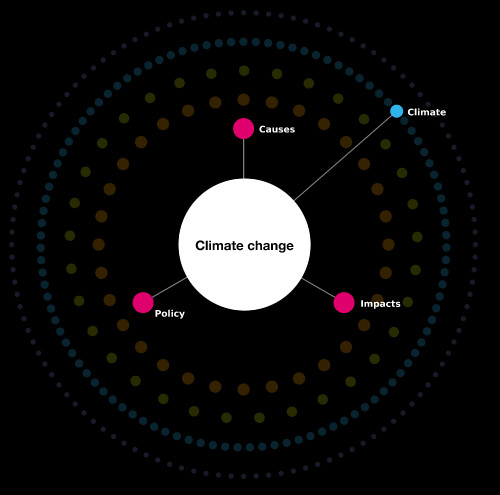Carbon is one of the building blocks of life. Humans, animals and plants are made up of organic compounds. We burn wood and fossil fuels to produce energy and power transport, inadvertently releasing the greenhouse gas, CO2 into the atmosphere.
1. Which fuels or activities produce more energy or CO2?
What are fossil fuels made up of? Hydrocarbons with varying amounts of Carbon:
- Coal contains large complex hydrocarbon molecules (with C:H:O ratios of ~85C:5H:10O)
- Diesel is made up of alkanes containing 12 or more carbon atoms. (e.g. C13H28)
- Petrol contains alkanes and cyclo-alkanes with between 5 and 12 Carbon atoms (with an average composition of C8H12 (octane))
- The mass of one mole of pure Carbon is 12 g and the mass of one mole of CO2 is 12 + (2×16) = 44 g (to convert from CO2e to C multiply by 12/44)
What are the combustion reactions and how much energy and CO2 do they produce?
- 1 kg of petrol burned yields about 47 MJ of energy (1litre, 34.2MJ)
- 1 kg of diesel burned yields about 46 MJ of energy (1litre, 38.6MJ) (diesel is denser than petrol and has more energy per litre)
- 1 kg of coal burned yields about 30 MJ of energy
- 1 kg of wood burned yields about 19 MJ of energy
- 1 kg of coal (containing 0.78 kg Carbon) will produce 2.4 kg of CO2
- 1 litre of petrol (containing 0.63 kg of carbon) will produce 2.3 kg of CO2
- 1 litre of diesel (containing 0.72 kg of carbon) will produce 2.7 kg of CO2
The most up-to-date information on the make-up of the UK electricity grid (which is a mix of sources) can be found at RENSmart and the value in February 2021 was that 1 kWh produces 0.23314 kg CO2. (kWh are calculated by multiplying kW by the number of hours). If you live in another country you could compare its CO2 emissions per kWh electricity factor. Here is a good comparison site for many countries but with older data.
2. How to quantify CO2 emissions in terms of volume and mass?
Volume and mass of CO2
You will often hear about kg of CO2 emitted, relating to the energy usage of different forms of transport, of a household, of a company, of a particular industry (like the cement industry) or of a country or a person.
From what we know about the combustion processes, their efficiency and our energy needs, we can use emission factors to calculate carbon footprints. We also know that a mole of any gas occupies 22.4 dm3 at ambient temperature. So we can express the emissions as a volume of CO2. If we know how much of a gas is emitted and what the original concentration of that gas was in the atmosphere, we can see whether the emissions will change the concentration.
- 1 kg pure CO2 occupies a volume of half a cubic metre (500 dm3 (or litres))
- CO2 emissions are often stated in GtC (109 tonnes (or Gigatonnes) of Carbon)
- Concentrations of CO2 in the atmosphere are expressed in parts per million by volume (ppmv). 1 ppmv takes up 0.0001% of the volume of the atmosphere. Check out the Mauna Loa CO2 measurement station in Hawai for today´s level.
- A release of CO2containing 1 GtC would increase the atmospheric CO2 concentration by 0.47 ppmv if all the CO2 remained in the atmosphere, BUT carbon sinks nearly balance out the sources
- There was a CO2 increase of 2.5 ± 0.1 ppmv between 2017 and 2018
- The lifetime of CO2 is 5 to 100 years
Don’t forget:
- The mass of one mole of pure Carbon is 12 g and the mass of one mole of CO2 is 12 + (2×16) = 44 g (to convert from CO2eq to C multiply by 12/44)
Effects of the Covid-19 on the economy and thus CO2 emissions
- Between 2019 and 2020 global CO2 emissions decreased due to the COVID-19 Pandemic (in the region of 4 Gt CO2 and the CO2 emissions fell by 7 % in 2020, the largest ever decrease since the Second World War!)
- A Carbon brief article suggests that in 2020 we reduced the annual increase in CO2 concentrations by 0.32ppmv, putting it at 2.48ppm.
- Note the difference between emissions of CO2 and actual concentrations. The CO2 already in the atmosphere from previous year´s emissions (it lasts up to one hundred years).
3. Steps towards carbon neutrality

This Figure shows the latest (calculated every 3 months) fuel source mix for the UK electricity supply. Go to: OFGEM. Note the elimination of coal and the increase in wind and solar energy.
The UK electricity supply now has well over 20 % from renewables. The UK is trying to get to below 100 g CO2/ kWh by 2030 and we might achieve 5 % renewables by 2025. In late 2019 the electricity from British windfarms, solar panels and renewable biomass plants surpassed fossil fuels for the first time since the UK’s first power plant fired up in 1882.
We saw in section 1 that at RENSmart you can get the latest value for how many kg CO2 are produced per kWh of electricity. Let´s compare other countries from the table at the bottom of this website. Sweden currently has an emission of 0.013 kg CO2/ kWh (21 times lower CO2 emissions per kWh!). In Sweden 80 % of electricity comes from nuclear and renewables (with 66 % from renewables). By the way, renewables do have an embedded energy (of up to 50 g CO2/ kWh).
And look what these natural Carbon Sinks can do:
- Between 1994 and 2007, the oceans absorbed 34 Gt CO2 (31 % of what humans put into the atmosphere during that time)
- One acre of new forest can sequester about 2.5 tons of carbon annually. Young trees absorb CO2 at a rate of 6 kg per tree each year and after 10 years they absorb 22 kg of CO2 per year. At that rate, they release enough oxygen back into the atmosphere to support two human beings.
References
Electricity generation mix by quarter and fuel source (GB), Ofgem website
Latest “UK CO2(eq) emissions due to electricity generation”, RENSmart website
Analysis: Half of UK’s electricity to be renewable by 2025, Carbon Brief, April 2019
Analysis: What impact will the coronavirus pandemic have on atmospheric CO2,? Carbon brief, May 2020
Renewable electricity overtakes fossil fuels in UK for first time, The Guardian, October 2019



